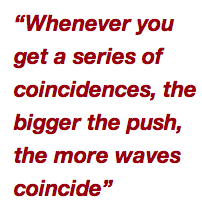Stocks & Equities
Successfully time one of these dramatic moves and you’ve created a big money making opportunity for yourself. Especially if you Shortsell the much quicker, more sudden & dramatic Bust moves. Then again if you are not a Shortseller, avoiding a Bust will at least save you a lot of capital as so many found out in 2008 when Blue chip Exxon lost 58% in 5 months, Microsoft 45% & Boeing fell from $88 to $30 – Money Talks Editor
More insights into long-wave theory…
– Readers don their K-wave caps and weigh in on this long-wave business…
– Why a 60-year-long wave theory should matter to you…
– Plus, Wayne Mulligan on how you can cut Wall Street out of your investments… the promise that crowdfunding offers investors.
“I agree with Mr. Rothbard’s opinion that government interference in the markets causes the boom and bust cycles,” writes one reader.
“But I also agree with the Elliott Wave and socionomics theories that market changes result from sentiments motivated by the thinking and mood changes of the masses (often unconscious), resulting in periods of economic change, booms, busts, wars, depressions, music, clothing styles, movies, etc.”
Hrmm… good point. Each theory definitely brings something to the table. Picking out when to apply each is the tricky part.
“OK, here’s my take on the K cycles,” writes a second reader, though we’re forced to trim her message down to fit our scarce space.
“First,” she explains, “maybe humans just need to go in cycles, and maybe it just takes about 60 years (plus or minus) for us to do it. After all, stock markets, economies, currency issues and interest rates are all human-generated (apes don’t bother with these things).
“Second, I think interest rates follow the K cycles pretty closely — give or take a bit for a hellbent Fed trying to ‘control’ interest rates. The last year or so would seem to indicate the Fed really can’t control interest rates as they would like us to believe. Time will tell for sure. But if interest rates do follow the K-wave, then there is reason for concern, as rising rates will certainly trounce the stock market and economy and seriously reduce the gummit’s disposable income (if it isn’t already).
“The K cycle does seem to match with recent history, so I suspect, against Rothbard’s suggestion, that there is some merit there. As you know, however, cycles work great until they don’t.”
 “There may be a grain of truth in Rothbard’s words,” writes a third reader, “that soothsayers merely adjust their predictions to fit the facts. However, as a trader, I see waves (cycles) daily.
“There may be a grain of truth in Rothbard’s words,” writes a third reader, “that soothsayers merely adjust their predictions to fit the facts. However, as a trader, I see waves (cycles) daily.
“Traders use such arcane technical analysis tools as RSI, MACD, stochastics, Elliott Waves, Bollinger Bands et al., and these are used to predict a change from positive to negative and vice versa.
“As these waves coincide, inevitably, they push the markets higher or lower in the direction of coincidence (i.e., the one-minute coincides with the five-minute, which coincides with the 15-minute — you get the idea). Whenever you get a series of coincidences, the bigger the push, the more waves coincide, the more in one direction or another the markets will move. Like the waves on the ocean, driven by the winds. However, these business waves are driven by us…”
Heh. We try to leave the “arcane” technical analysis to our friend at theRude Awakening, Greg Guenthner. As for the Kondratiev wave theory, the basic premise seems reasonable enough to us.
Over periods of time, technological advances make people more productive. Business picks up. As people become more confident… their enthusiasm grows to a point where they start to give credence to business ideas and investments that make no sense. We suspect a politician or central bank is somewhere in the mix, too.
People start to take on too much debt. They pay ridiculous prices for certain assets because they either are too wrapped up in the market to realize their true value, or they’re hoping someone else is a greater fool. Eventually, at some point, someone stops for a second and asks what the hell is going on… and the fantasy is brought to a standstill, and then is shattered altogether. Phew…
 And if all of that happens in 60 years or so… well, we guess you can call it a K-wave. But really, we’d feel more comfortable calling it with the benefit of hindsight.
And if all of that happens in 60 years or so… well, we guess you can call it a K-wave. But really, we’d feel more comfortable calling it with the benefit of hindsight.
Conveniently, as we write this to you, two reader messages plopped into our mailbag.
“Just who could use a long, irregular 60-year cycle?” one of the readers asks. “Isn’t a four-year cycle tough enough for most people?”
“While I agree with the wave theory,” writes the other reader, “I have to admit I agree with the statement that ‘markets can remain irrational longer than I can remain solvent.’ Since I have only 30 years, at best, years left, what should I do to insure I can take care of myself over this period?”
Glad you asked. Just what is the whole point of this discussion? Sixty years is a lifetime for some people… if they’re fortunate. What good is the long run? That’s when we’re all dead, you might be thinking.
Well, not everyone! Your editor has big plans 60 years from now! Besides, what if we’re on the cusp of a new cycle? What new innovations could we see in the near term? How would they change the way we live? Is this just a pipe dream? Has this abstract 60-year K-wave stuff driven us completely unbalanced and stark raving mad?!
Well, we hate to do this to you…. but you’ll have to tune in next week to find out. Today is Friday. Who wants to go down a rabbit hole as the weekend stares them in the face? Nobody, that’s who.
(OK… fine. If you’re really dying to talk about K-waves, we won’t leave you out in the cold. You can reach us here: peter@dailyreckoning.com.)
In the meantime, we’ll leave you in the hands of Wayne Mulligan. In today’s episode, he explains a new investment opportunity that is going to come into its own in the coming months. We’re very excited about it.
Then, in today’s DR PRO, Ryan O’Connor cuts Twitter down to size… and explains why one play he’s recommended (already up 31% to date) is still a buy. If you haven’t upgraded yet, you’re missing out on Ryan’s market-crushing picks. Why don’t you click here to upgrade, already!

Yesterday during her Senate confirmation hearings, Janet Yellen, the presumptive next Chairman of the U.S. Federal Reserve, was quoted saying: “There is limited evidence of reach for yield.” I can only assume that Dr. Yellen does not have access to a Bloomberg machine, or is not following the markets, or is not reading my blog comments and tweets! (https://twitter.com/McIverWealth)
In order to assist Dr. Yellen, I will take the opportunity to present a number of pieces of evidence that she has apparently missed.
1.The popularity of Rwandan government bonds is evidence of a reach for yield. Because investors have suffered from interest rate suppression, they have had to venture far and wide to find ways to supplement yield. They have even ventured as far as “frontier markets” such as Rwanda! (That’s right, the agrarian country that is synonomous with savage ethnic cleaning that claimed 100,000s of lives in the 1990s). As the first chart above points out, investor enthusiasm is such that the Rwandan government 10-years are currently yielding a miserly 7.86% despite being a country that has seen explosive inflationary bursts over the past decade.
2.The popularity of U.S. Real-Estate Income Trusts (REITs) is evidence of a reach for yield. Although as a whole this sector was whipsawed a bit during the first utterance of Fed “Taper Talk” in May, it has largely held onto gains made over the past two years (see second chart above) as investors find it hard to ignore the yields.
3.The popularity of High Yield Bonds is evidence of a reach for yield. In fact, the higher yields from lower quality bonds have been so seductive, investors in these bonds have ignored the fact that the market for conventional safer bonds has been in a Bear Market since July 2012 (see third chart above).
I am a bit surprised that an ocean of Ph.D.’s at the Fed wasn’t enough to help Dr. Yellen with her talking points. However, if she is able to read some of the “tip of the iceberg” evidence about the “reach for yield” that I have presented here, she’ll be a little more prepared then next time she comments on the subject.
The opinions expressed in this report are the opinions of the author and readers should not assume they reflect the opinions or recommendations of Richardson GMP Limited or its affiliates. Assumptions, opinions and estimates constitute the author’s judgment as of the date of this material and are subject to change without notice. We do not warrant the completeness or accuracy of this material, and it should not be relied upon as such. Before acting on any recommendation, you should consider whether it is suitable for your particular circumstances and, if necessary, seek professional advice. Past performance is not indicative of future results.
Richardson GMP Limited, Member Canadian Investor Protection Fund.
Richardson is a trade-mark of James Richardson & Sons, Limited. GMP is a registered trade-mark of GMP Securities L.P. Both used under license by Richardson GMP Limited.


On November 18 at 1:28pm ET, MAVEN will launch on a 10-month flight to Mars to better understand the planet’s atmosphere, climate, liquid water, and planetary habitability. In other words: could live on Mars exist in the future — and was there any life that existed on the planet in the past.
The Mars Atmosphere and Volatile EvolutioN (MAVEN) mission is part of NASA’s Mars Scout program.

U.S. manufacturing output rose for a third straight month in October even as automobile production fell, suggesting a broadening in activity in a sector regaining momentum after a slump early this year.
Other data on Friday showed factory activity fell in New York state early this month, but economists said that was probably a delayed reaction to last month’s 16-day partial shutdown of the federal government.
National manufacturing output increased 0.3 percent after edging up 0.1 percent in September, the Federal Reserve said. In the 12 months through October, factory production was up 3.3 percent, the fastest since December 2012.
The monthly increase, which matched economists’ expectations, was despite a 1.3 percent fall in auto production. Auto assembly fell for the first time since July.











